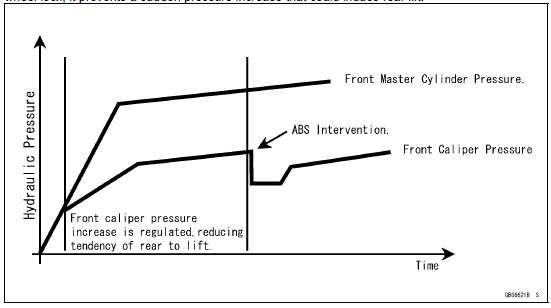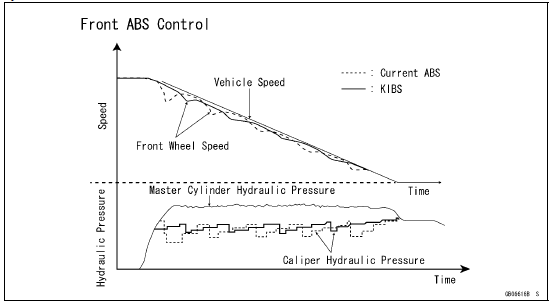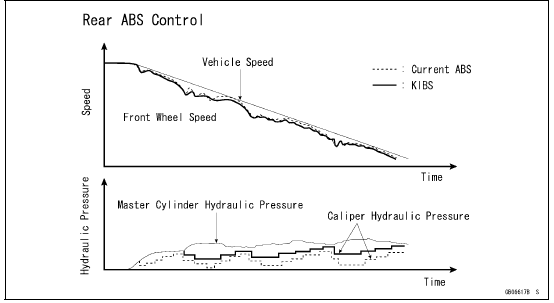


KIBS Control
1. ABS performance equivalent to the current model (enhanced braking stability)
By monitoring front caliper hydraulic pressure, KIBS regulates pressure increases reducing the tendency of the rear to lift. Before the ABS system fully reacts, KIBS system prevents the pressure from increasing too quickly thus suppressing rear lift. And after the ABS has decreased pressure to prevent wheel lock, it prevents a sudden pressure increase that could induce rear lift.

2. High-precision ABS to enhance front and rear braking performance
By monitoring front caliper hydraulic pressure, the KIBS system is able to regulate pressure changes precisely, so that slips are minimized resulting in smooth operation compared to the conventional ABS system.

3. Rear brake control enhancement during engine braking
By recognizing rear wheel slip due to engine brake force during aggressive throttle operation, and at high rpm or downshifting, the KIBS system prevents unnecessary ABS intervention to the rear wheel compared to the conventional ABS system.

 System Components
System Components Technical Information - Electronic Steering Damper (ESD/ZX1000JD/KD models)
Technical Information - Electronic Steering Damper (ESD/ZX1000JD/KD models)Footpeg
Footpeg Height Adjustment
The front footpeg can be adjusted within 2 positions in
height to suit the rider’s preference.
Footpeg [A]
Bolts [B]
Bolt Holes [C]
Footpeg Position 1 [D]
Footpeg Position 2 [E]
Remove the bolts [A].
Adjust the footpeg height.
NOTE
In ...
Wheel Inspection
Raise the front/rear wheel off the ground.
Special Tools - Jack: 57001-1238
Jack Attachment: 57001-1608
Spin the wheel lightly, and check for roughness or binding.
If roughness or binding is found, replace the hub bearings
(see Hub Bearing Removal/Installation).
Inspect the wh ...
Air Intake Duct Disassembly
(Other than US, CA and CAL Models)
Remove:
Air Intake Duct (see Air Intake Duct Removal)
Seal [A] and Screen [B]
Turn the air intake valve actuator [C] counterclockwise
(90°).
Remove the shaft [A] of the air intake valve actuator.
Remove:
Pad [A]
Screws [B]
Air Intake Valve [C]
...